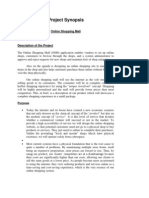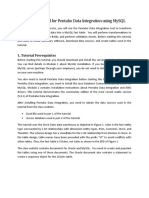Online Store Locator Using PHP, MySQL and Google Maps API
Uploaded by
Aureliano DuarteOnline Store Locator Using PHP, MySQL and Google Maps API
Uploaded by
Aureliano DuarteOnline Store Locator using PHP, MySQL and Google Maps API
Posted on February 3, 2013 by theoryapp Where is the closest McDonalds? This tutorial shows how to build a map-based locator for finding the closest stores. We will use PHP and MySQL for the backend and JavaScript with Google Maps API for the front end.
Setup the Database
The dataset here contains geographical locations of all McDonalds in North America. It is a CSV (Comma-Separated Values) file with three columns: longitude, latitude and address. There are 15163 locations. 1-122.994495, 49.281079, 4805 E Hastings St Burnaby BC V5C 2L1 2-123.024074, 49.265642, 3695 Lougheed Hwy Vancouver BC V5M 2A6 3...... The SQL statement to create the table is as below: 1CREATE TABLE `data_mcdonalds` ( 2 `id` INT NOT NULL AUTO_INCREMENT PRIMARY KEY, 3 `lat` DOUBLE NOT NULL, 4 `lng` DOUBLE NOT NULL, 5 `address` VARCHAR(64) NOT NULL ); 6 Then we can import the data from the CSV file to the database. Note that, we need specify the column names to be lng, lat, address when importing.
Search the Closest Stores
There are two ways to search for the stores. One is to specify the central location (lat, lng) and find the closest stores based on their distance to the center. Another way is to specify a bounding box (ranges of lat and lng) and find all stores within the bound. Searching by a bounding box is easy. Suppose we have the bounding box specified by four parameters: lat0, lat1, lng0, lng1. The following query find all stores within a box. 1SELECT * 2FROM `data_mcdonalds` 3WHERE lat >= lat0 AND lat <= lat1 AND lng >= lng0 AND lng <= lng1; 4 Searching with a center requires calculating the distance. Suppose we have the center at (lat0, lng0), the following query find the closest 20 stores within 50 miles.
1 SELECT *, 2 ( 3959 * acos( cos(radians(lat0)) * cos(radians(lat)) * 3 cos(radians(lng) - radians(lng0)) + sin(radians(lat0)) * sin(radians(lat)) ) ) AS distance 4 FROM `data_mcdonalds` 5 HAVING distance < 50 6ORDER BY distance LIMIT 20; 7
Generate JSON Output
Next we use PHP to dynamically query the database and generate the result. 1 <?php 2 function die_with_error($error) { $ret = array( 3 "status" => "Failed", 4 "error" => $error 5 ); die(json_encode($ret)); 6 } 7 8 $lat = $_GET["lat"]; 9 $lng = $_GET["lng"]; 10if (!$lat || !$lng) die_with_error("invalid parameters"); 11 12 13$hostname = '111.111.111.111'; = 'xxxxxx'; 14$username $password = 'xxxxxx'; 15$dbname = 'xxx'; 16 17mysql_connect($hostname, $username, $password) or die_with_error(mysql_error()); 18 mysql_select_db($dbname) or die_with_error(mysql_error()); 19 mysql_set_charset('utf8'); 20 21$query = sprintf("SELECT *, 22 round( 3959 * acos( cos(radians(%s)) * cos(radians(lat)) * cos(radians(lng) - radians(%s)) + sin(radians(%s)) * 23 sin(radians(lat)) ), 2 ) AS distance 24 FROM `data_mcdonalds` 25 HAVING distance < 50 26 ORDER BY distance LIMIT 30;", 27 mysql_real_escape_string($lat), mysql_real_escape_string($lng), 28 mysql_real_escape_string($lat)); 29 $result = mysql_query($query); 30if (! $result) 31 die_with_error(mysql_error()); 32 33$result_array = array(); 34while ($row = mysql_fetch_assoc($result)) { array_push($result_array, array( 35 "id" => $row['id'], 36 "lat" => $row['lat'], 37 "lng" => $row['lng'], "address" => $row['address'], 38
"distance" => $row['distance'] 39 )); 40 } 41 42$ret = array( 43 "status" => "OK", "data" => $result_array); 44 die(json_encode($ret)); 45 46?> 47 48 49 50 51 52 53 54
An example output can be found using this link.
Build the Map
Next we are ready to build a map using Google Maps API. In the HTML code, we define the following elements. 1<input id="address" type="text" value="Vancouver" /> 2<input id="search" type="submit" value="Search" /> 3<div id="map_canvas" style="height: 600px; width: 800px;"> 4</div> The following is the JavaScript code. 1 var map = null; var geocoder = null; 2 var markers = []; 3 var infoWindow = null; 4 5 jQuery('#search').click(function() { var address = jQuery('#address').val() || 'Vancouver'; 6 if (map === null) 7 initializeMap(); 8 searchAddress(address); 9 }); 10 11function initializeMap() { var mapOptions = { 12 zoom: 13, 13 mapTypeId: google.maps.MapTypeId.ROADMAP 14 } map = new google.maps.Map( 15 document.getElementById('map_canvas'), mapOptions); 16 geocoder = new google.maps.Geocoder(); 17 infoWindow = new google.maps.InfoWindow(); 18} 19
20function searchAddress(address) { geocoder.geocode( { 'address': address}, 21 function(results, status) { 22 if (status === google.maps.GeocoderStatus.OK) { 23 var latlng = results[0].geometry.location; map.setCenter(latlng); 24 searchStores(latlng.lat(), latlng.lng()); 25 } else { 26 alert('Address not found: ' + status); 27 } 28 }); 29} 30 31function searchStores(lat, lng) { var url = './store-ajax.php'; 32 var parameter = { lat: lat, lng: lng }; 33 jQuery.ajax({ url: url, 34 data: parameter, 35 dataType: 'json', 36 success: showStores 37 }); 38} 39 40function showStores(data, status, xhr) { if (data['status'] != 'OK') 41 return; 42 43 infoWindow.close(); 44 for (var i = 0; i < markers.length; i++) { 45 markers[i].setMap(null); } 46 markers.length = 0; 47 48 for (var i in data['data']) { 49 createMarker(data['data'][i]); 50 } 51} 52 53function createMarker(store) { var latlng = new google.maps.LatLng( 54 parseFloat(store['lat']), 55 parseFloat(store['lng']) 56 ); var html = "<b>" + store['address'] + "</b>" + 57 store['distance'] + " miles"; 58 var marker = new google.maps.Marker({ 59 map: map, 60 position: latlng }); 61 google.maps.event.addListener(marker, 'click', function() { 62 infoWindow.setContent(html); 63 infoWindow.open(map, marker); 64 }); 65 markers.push(marker); } 66
You might also like
- Autodesk Model Checker For Revit: Power BI Dashboard Visualization ThresholdsNo ratings yetAutodesk Model Checker For Revit: Power BI Dashboard Visualization Thresholds9 pages
- Test Scenario For Online Marketplace.: Test Scenario # Requirement Itest Scenario Description Test CasesNo ratings yetTest Scenario For Online Marketplace.: Test Scenario # Requirement Itest Scenario Description Test Cases1 page
- Software Requirement Engineering ProjectNo ratings yetSoftware Requirement Engineering Project31 pages
- Project Report On Online Story Sharing Website100% (1)Project Report On Online Story Sharing Website125 pages
- WWW - Kashipara.in: A Project Report OnNo ratings yetWWW - Kashipara.in: A Project Report On58 pages
- Electronics Ecommerce Website: 1) Background/ Problem StatementNo ratings yetElectronics Ecommerce Website: 1) Background/ Problem Statement7 pages
- Price Comparison Website For Online Shopping ProjectNo ratings yetPrice Comparison Website For Online Shopping Project5 pages
- Telecom CRM Big Data Analytics For Tariff Plan Design: Puja Shrivastava, DR - LaxmansahooNo ratings yetTelecom CRM Big Data Analytics For Tariff Plan Design: Puja Shrivastava, DR - Laxmansahoo4 pages
- WWW Freeprojectz Com Uml Diagram Car Service Center Management System Uml DiagramNo ratings yetWWW Freeprojectz Com Uml Diagram Car Service Center Management System Uml Diagram30 pages
- Online Watches Shopping: Software Requirements Specification DocumentNo ratings yetOnline Watches Shopping: Software Requirements Specification Document20 pages
- Software Requirements Specification For: COMSATS University Islamabad, Park Road, Chak Shahzad, Islamabad PakistanNo ratings yetSoftware Requirements Specification For: COMSATS University Islamabad, Park Road, Chak Shahzad, Islamabad Pakistan173 pages
- SDS Online Shopping Application ProjectNo ratings yetSDS Online Shopping Application Project10 pages
- Online Marriage Registration System InroductionNo ratings yetOnline Marriage Registration System Inroduction3 pages
- Restaurant Reservation Website DocumentationNo ratings yetRestaurant Reservation Website Documentation30 pages
- Enhancing Virtual Intranet Server Full Doc (Editing)No ratings yetEnhancing Virtual Intranet Server Full Doc (Editing)56 pages
- Mini Project Report - Format (2023-24) (AI)No ratings yetMini Project Report - Format (2023-24) (AI)20 pages
- The Datadog Handbook: A Guide to Monitoring, Metrics, and TracingFrom EverandThe Datadog Handbook: A Guide to Monitoring, Metrics, and TracingNo ratings yet
- Use PHP, MySql and Google Map API v3 For Displaying Data On Map100% (1)Use PHP, MySql and Google Map API v3 For Displaying Data On Map6 pages
- Spring Boot Thymeleaf CRUD Database Real-Time ProjectNo ratings yetSpring Boot Thymeleaf CRUD Database Real-Time Project58 pages
- Create Spring Boot Project With Spring InitializerNo ratings yetCreate Spring Boot Project With Spring Initializer4 pages
- Spring Boot, MySQL, JPA, Hibernate Restful CRUD API TutorialNo ratings yetSpring Boot, MySQL, JPA, Hibernate Restful CRUD API Tutorial15 pages
- Create Spring Boot Project in Spring Tool Suite (STS)No ratings yetCreate Spring Boot Project in Spring Tool Suite (STS)3 pages
- Spring Boot Thymeleaf CRUD Database Real-Time ProjectNo ratings yetSpring Boot Thymeleaf CRUD Database Real-Time Project58 pages
- Socket Programming and Exploiting With PHPNo ratings yetSocket Programming and Exploiting With PHP32 pages
- TK103 GPS Vehicle Tracker Collection of Commands0% (1)TK103 GPS Vehicle Tracker Collection of Commands1 page
- PHP - Google Maps - How To Get GPS Coordinates For AddressNo ratings yetPHP - Google Maps - How To Get GPS Coordinates For Address4 pages
- Creating Webservice Server and Client Using NuSOAPNo ratings yetCreating Webservice Server and Client Using NuSOAP4 pages
- Create A PHP Webservice in 5min, Using PHP, SOAP and WSDL Technology, NuSOAPNo ratings yetCreate A PHP Webservice in 5min, Using PHP, SOAP and WSDL Technology, NuSOAP5 pages
- Visual Studio Team System 2008 Team Foundation Server - Manage Enterprise - Level Application Develop MenNo ratings yetVisual Studio Team System 2008 Team Foundation Server - Manage Enterprise - Level Application Develop Men42 pages
- Body (Background-Color:#d0e4fe ) h1 (Color:orange Text-Align:center ) P (Font-Family:"times New Roman" Font-Size:20px )No ratings yetBody (Background-Color:#d0e4fe ) h1 (Color:orange Text-Align:center ) P (Font-Family:"times New Roman" Font-Size:20px )2 pages
- Diploma in Computer Application (First Semester) Examination, February 2019No ratings yetDiploma in Computer Application (First Semester) Examination, February 20193 pages
- Guided Tutorial For Pentaho Data Integration Using MysqlNo ratings yetGuided Tutorial For Pentaho Data Integration Using Mysql39 pages
- Comparing Databases For An Industrial IoT Use-Case: MongoDB, TimescaleDB, InfluxDB and CrateDBNo ratings yetComparing Databases For An Industrial IoT Use-Case: MongoDB, TimescaleDB, InfluxDB and CrateDB6 pages
- Q & A Exam (Adv V11) Q & A Exam (Adv V11) : Review Your AnswersNo ratings yetQ & A Exam (Adv V11) Q & A Exam (Adv V11) : Review Your Answers7 pages
- Isilon Supportability and CompatibilityNo ratings yetIsilon Supportability and Compatibility36 pages
- More SQL: Complex Queries, Triggers, Views, and Schema ModificationNo ratings yetMore SQL: Complex Queries, Triggers, Views, and Schema Modification37 pages









































































































